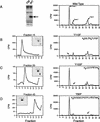Mos positively regulates Xe-Wee1 to lengthen the first mitotic cell cycle of Xenopus
- PMID: 10072389
- PMCID: PMC316506
- DOI: 10.1101/gad.13.5.620
Mos positively regulates Xe-Wee1 to lengthen the first mitotic cell cycle of Xenopus
Abstract
Several key developmental events occur in the first mitotic cell cycle of Xenopus; consequently this cycle has two gap phases and is approximately 60-75 min in length. In contrast, embryonic cycles 2-12 consist only of S and M phases and are 30 min in length. Xe-Wee1 and Mos are translated and degraded in a developmentally regulated manner. Significantly, both proteins are present in the first cell cycle. We showed previously that the expression of nondegradable Mos, during early interphase, delays the onset of M phase in the early embryonic cell cycles. Here we report that Xe-Wee1 is required for the Mos-mediated M-phase delay. We find that Xe-Wee1 tyrosine autophosphorylation positively regulates Xe-Wee1 and is only detected in the first 30 min of the first cell cycle. The level and duration of Xe-Wee1 tyrosine phosphorylation is elevated significantly when the first cell cycle is elongated with nondegradable Mos. Importantly, we show that the tyrosine phosphorylation of Xe-Wee1 is required for the Mos-mediated M-phase delay. These findings indicate that Mos positively regulates Xe-Wee1 to generate the G2 phase in the first cell cycle and establish a direct link between the MAPK signal transduction pathway and Wee1 in vertebrates.
Figures







Similar articles
-
Activation of Wee1 by p42 MAPK in vitro and in cycling xenopus egg extracts.Mol Biol Cell. 2000 Mar;11(3):887-96. doi: 10.1091/mbc.11.3.887. Mol Biol Cell. 2000. PMID: 10712507 Free PMC article.
-
Analysis of the early embryonic cell cycles of Xenopus; regulation of cell cycle length by Xe-wee1 and Mos.Development. 1998 Jan;125(2):237-48. doi: 10.1242/dev.125.2.237. Development. 1998. PMID: 9486797
-
Cell cycle regulation of a Xenopus Wee1-like kinase.Mol Biol Cell. 1995 Jan;6(1):119-34. doi: 10.1091/mbc.6.1.119. Mol Biol Cell. 1995. PMID: 7749193 Free PMC article.
-
Regulation of the meiotic cell cycle in oocytes.Curr Opin Cell Biol. 2000 Dec;12(6):666-75. doi: 10.1016/s0955-0674(00)00150-2. Curr Opin Cell Biol. 2000. PMID: 11063930 Review.
-
WEE1 tyrosine kinase, a novel epigenetic modifier.Trends Genet. 2013 Jul;29(7):394-402. doi: 10.1016/j.tig.2013.02.003. Epub 2013 Mar 26. Trends Genet. 2013. PMID: 23537585 Free PMC article. Review.
Cited by
-
Modulation of cell cycle control during oocyte-to-embryo transitions.EMBO J. 2013 Aug 14;32(16):2191-203. doi: 10.1038/emboj.2013.164. Epub 2013 Jul 26. EMBO J. 2013. PMID: 23892458 Free PMC article. Review.
-
Activation of Wee1 by p42 MAPK in vitro and in cycling xenopus egg extracts.Mol Biol Cell. 2000 Mar;11(3):887-96. doi: 10.1091/mbc.11.3.887. Mol Biol Cell. 2000. PMID: 10712507 Free PMC article.
-
Apoptotic regulation by the Crk adapter protein mediated by interactions with Wee1 and Crm1/exportin.Mol Cell Biol. 2002 Mar;22(5):1412-23. doi: 10.1128/MCB.22.5.1412-1423.2002. Mol Cell Biol. 2002. PMID: 11839808 Free PMC article.
-
Multisite M-phase phosphorylation of Xenopus Wee1A.Mol Cell Biol. 2005 Dec;25(23):10580-90. doi: 10.1128/MCB.25.23.10580-10590.2005. Mol Cell Biol. 2005. PMID: 16287869 Free PMC article.
-
Absence of Wee1 ensures the meiotic cell cycle in Xenopus oocytes.Genes Dev. 2000 Feb 1;14(3):328-38. Genes Dev. 2000. PMID: 10673504 Free PMC article.
References
-
- Abrieu A, Lorca T, Labbe J-C, Morin N, Keyse S, Doree M. MAP kinase does not inactivate, but rather prevents the cyclin degradation pathway from being turned on in Xenopus egg extracts. J Cell Sci. 1996;109:239–246. - PubMed
-
- Aligue R, Wu L, Russell P. Regulation of Schizosaccharomyces pombe Wee1 tyrosine kinase. J Biol Chem. 1997;272:13320–13325. - PubMed
Publication types
MeSH terms
Substances
LinkOut - more resources
Full Text Sources
Miscellaneous
